Louisiana’s Cajun Country
Posted on October 2, 2016 by bob in Travel
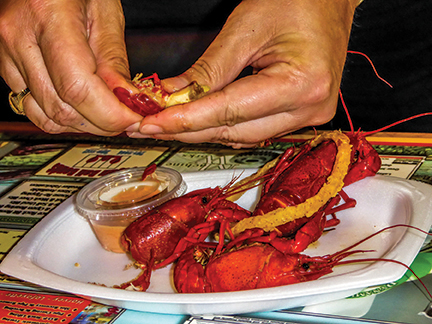
Legend has it that Canadian lobster shriveled to Louisiana crawfish under the heat of the southern sun.
Story by Andrea Gross | Photos by Irv Green
(Editor’s Note: Lafayette is recovering from recent floodings. Assistance can be provided through a number of agencies, including the American Red Cross, www.redcross.org, and Louisanna Flood Recovery, http://lafloodrecovery.org/.)
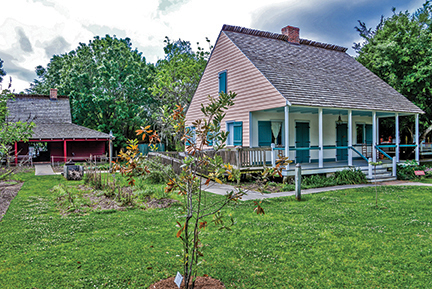
Cajuns found gardening easier in Louisiana than in Canada.
Challenging the Queen of England isn’t a job for the average attorney, yet Warren Perrin speaks of it casually, as if waging a legal war against the British crown is no big deal. In fact, it was a very big deal — not only for Perrin, but also for the half million people he represents: the Cajuns of South Louisiana.
The Louisiana litigator claimed the Crown owed the Cajuns an apology for deporting their French-speaking ancestors from Canada back in 1755. When the Acadians (French colonists) refused to bow to the British king, they were separated from their families, pushed onto small boats and forced out to sea. More than one third lost their lives, others were dispersed throughout the American colonies, and some eventually made it to south Louisiana, where they were welcomed by a largely French-speaking populace.
But as the saying goes, one man’s misfortune is another man’s good luck. Having lost so much, the Acadians, whose name evolved into Cajun, were determined to hang on to what they had left. Today, more than 260 years later, many of their traditions remain intact, making south Louisiana one of the most distinctive regions in the oft-homogenous United States.
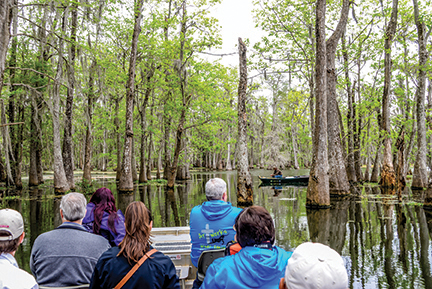
Swamp tours are conducted in small, flat-bottomed boats.
Using Lafayette (www.lafayettetravel.com) as our hub, my husband and I begin our immersion into Cajun culture by exploring the surroundings that greeted the new arrivals. To do this, we tour the swamps with Bryan Champagne, whose flat-bottomed boat can slide over logs, weave through tunnels of moss-draped cypress trees and carve paths that take us past egret nests and snoozing gators. How different this environment must have seemed to folks who were used to Canadian winters!
Within a few short years, the Cajuns were building sturdy homes on dry ground. We see a typical Cajun community at Vermilionville, a heritage and folk life park that depicts Acadian life between 1765 and 1890. There’s a school, boat shed, forge and church as well as a variety of homes. One is a trapper’s hut, another replicates a native American dwelling and some are like those that belonged to Cajun and Creole families.
But Vermilionville is about more than the distant past. The costumed interpreters, who demonstrate crafts such as violin making, quilting, and blacksmithing, generally grew up in the area and their discussions — as well as some of the exhibits — tell us about Cajun life in more recent times as well.
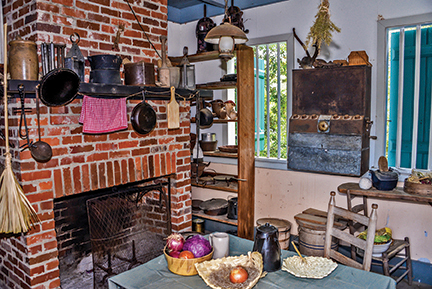
The kitchen was the heart of Cajun homes.
We enter L’École, a reproduction of a mid twentieth-century schoolhouse. Up front is a giant U.S. flag with 48 stars. Below, on the blackboard, is an edict that the children were forced to copy during daily lessons: “I will not speak French on the school grounds.” A ninety-plus year old gentleman is on hand to tell visitors how difficult that made life for the Cajuns. “We spoke Cajun at home, yet from 1916 until 1968 we couldn’t even speak French among ourselves on the playground,” he says. “Without a common language, it was hard to pass down our traditions.”
But the Cajuns managed. People eat crawfish in restaurants filled with traditional music and dance to age-old tunes at weekly jamfests. We return to Vermilionville on Saturday afternoon to find approximately two dozen folks playing fiddles, guitars and accordions before an audience composed mostly of friends and neighbors. A man next to me invites me to dance. I have two left feet, but the music is so inviting I give it a try.
Finally, in order to enrich our minds while stuffing our stomachs, we sign up for a 3.5 hour tour that stops at six eateries, where people feed us Cajun stories along with Cajun food.
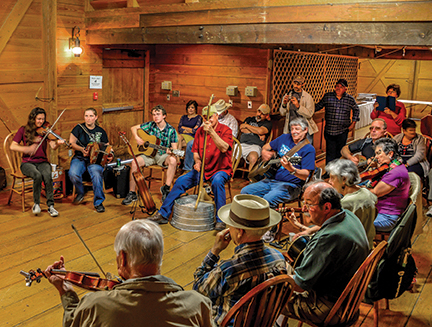
Visitors can hear traditional Cajun music at Vermilionville’s weekly jamfests.
According to the Legend of the Shriveling Lobsters, when the Acadians were forced out of Canada, the unhappy lobsters followed the castaways to Louisiana. There, unaccustomed to Southern heat, the poor crustaceans shrunk until voilà, they became crawfish.
Today crawfish are a staple in Cajun cooking and are often used in gumbo, jambalaya, bisque, boulettes, etouffée, maque choux, rice dressing and even cornbread. But the most authentic way to eat them is whole, a multi-step twist-suck-and-crack operation that tangles my fingers as it tempts my tastebuds. Fortunately, practicing is a lot of fun!
Meanwhile, Warren Perrin was successful in winning his royal battle. In 2003 Queen Elizabeth II issued a proclamation decreeing July 28th as an annual “Day of Commemoration of the Acadian Deportation.” It wasn’t exactly an apology, but at least it was an acknowledgement that the Acadians had indeed been expelled against their will and suffered greatly as a result.
Now — thanks in large part to Perrin — French, albeit with a Parisian rather than a Cajun accent, is being offered in all Louisiana schools.
Laissez les bos temps rouler! [Let the good times roll!]
For more on Lafayette and Cajun culture, go to www.traveltizers.com. For helpful tips on travel in Louisiana, see the section titled Napkin Notes.









